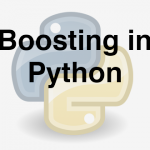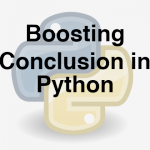
Link to the previous post : https://statinfer.com/204-7-7-boosting/
In the last post we covered the concepts and theory behind Boosting Algorithms.
In this post we will put the concepts into practice and build Boosting models using Scikit Learn in python.
Boosting
- Rightly, categorizing the items based on their detailed feature specifications. More than 100 specifications have been collected.
- Data: Ecom_Products_Menu/train.csv
- Build a decision tree model and check the training and testing accuracy.
- Build a boosted decision tree.
- Is there any improvement from the earlier decision tree.
In [20]:
#importing the datasets
menu_train=pd.read_csv("datasets\\Ecom_Products_Menu\\train.csv")
menu_test=pd.read_csv("datasets\\Ecom_Products_Menu\\test.csv")
In [21]:
lab=list(menu_train.columns[1:101])
g=menu_train[lab]
h=menu_train['Category']
In [22]:
###buildng Decision tree on the training data ####
from sklearn import tree
tree = tree.DecisionTreeClassifier()
tree.fit(g,h)
Out[22]:
In [23]:
#####predicting the tree on test data ####
tree_predict=tree.predict(menu_test[lab])
from sklearn.metrics import f1_score
f1_score(menu_test['Category'], tree_predict, average='micro')
Out[23]:
In [24]:
###Building a gradient boosting clssifier ###
from sklearn import ensemble
from sklearn.ensemble import GradientBoostingClassifier
boost=GradientBoostingClassifier(loss='deviance', learning_rate=0.1, n_estimators=100, subsample=1.0, min_samples_split=2, min_samples_leaf=1, min_weight_fraction_leaf=0.0, max_depth=3, init=None, random_state=None, max_features=None, verbose=0, max_leaf_nodes=None, warm_start=False, presort='auto')
In [25]:
##calculating the time while fitting the Gradient boosting classifier
import datetime
start_time = datetime.datetime.now()
##fitting the gradient boost classifier
boost.fit(g,h)
end_time = datetime.datetime.now()
print(end_time-start_time)
In [26]:
###predicting Gradient boosting model on the test Data
boost_predict=boost.predict(menu_test[lab])
from sklearn.metrics import f1_score
f1_score(menu_test['Category'], boost_predict, average='micro')
Out[26]:
We see an accuracy of 78% after Gradient boosting model,where as it is 70% in decison tree building. Our accuracy has improved by 8%.
ADA Boosting
In [27]:
##building an AdaBoosting Classifier ####
from sklearn import ensemble
from sklearn.ensemble import AdaBoostClassifier
ada=AdaBoostClassifier(base_estimator=None, n_estimators=50, learning_rate=1.0, algorithm='SAMME.R', random_state=None)
ada.fit(g,h)
Out[27]:
In [28]:
### Predicting the AdaBoost clssifier on Test Data
ada_predict=ada.predict(menu_test[lab])
from sklearn.metrics import f1_score
f1_score(menu_test['Category'], ada_predict, average='micro')
Out[28]:
The next post is about boosting conclusion.
Link to the next post : https://statinfer.com/boosting-conclusion/



